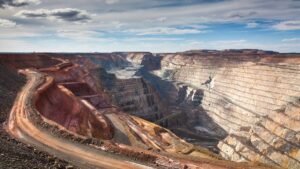Cash is running dry for miners in Canada, gold, rare earths and lithium explorers are making a beeline for the ASX

Pic: kostik2photo/iStock via Getty Images
- An increasing number of TSX companies are looking to dual list on the ASX as liquidity for Canadian junior explorers dries up
- Brazilian rare earths hopeful Resouro Gold is the latest to reveal plans for an ASX tilt
- De Grey-backed gold explorer Novo Resources has shown investor appetite is there for companies that make the switch
Minerals explorers from the TSX are making a dash for the Australian bourse at a quickening pace in a raid on Sydney’s capital markets that could create an arbitrage for Canadian investors.
Brazilian rare earths and titanium play Resouro Gold (TSX-V:RAU) is the latest to show its hand, tapping Aussie insto Regal Funds Management in a $3.2 million raising ahead of a planned tilt at the boards of the ASX.
Already up 350% from its lowest point of 12 Canuck cents in March to 54c yesterday and with a market cap of C$33 million ($38m) its CEO Chris Eager says a massive arbitrage exists for the owner of what he says will be a large scale titanium and rare earths deposit at Tiros in Brazil’s resource rich Minas Gerais state.
“I think the Australian market’s sort of waking up to what we have because we’re starting to do some publicity and promoting of the stock in Australia,” he said.
“I’m in Beaver Creek at the moment and I’ve had back to back meetings with funds from all over the world and from Australia and everyone recognises the value.
READ: Canada Unearthed: The Canadians are Coming, The Canadians are Coming
“We’ve got a $40 million Canadian market cap and our comparables are trading at a multiple of that.”
Resouro holds 33% of Tiros with an option to buy a 90% stake. It is hoping to draw comparisons to ASX wonder stock Meteoric Resources (ASX:MEI), up 2050% in the past year to a market cap of almost $410 million on the discovery of a super high grade ionic clay rare earths deposit at Caldeira in Brazil.
Gina Rinehart-backed Brazilian Rare Earths is also believed to be planning an ASX IPO. While Australian investors can buy shares on the TSX right now, Eager believes they will be valued far more favourably in the Australian marketplace.
More to come
Resouro isn’t the only ASX hopeful planning to dual list from a primary Canadian listing, with BDO’s head of global natural resources Sherif Andrawes telling Stockhead a wave of maple loving Canadians were packing their hockey sticks for Sydney.
Eager, who led London AIM listed Peruvian copper explorer Monterrico Minerals from 2001 to 2007 before its near US$200 million sale to a Chinese consortium, said the move to the ASX was all about liquidity.
While TSX investors had been cool on Resouro’s Brazilian assets, Sydney brokers and fund managers were immediately supportive of the story.
“Liquidity is the issue. We did an RTO on the TSX-V in April last year and didn’t trade for a year,” Eager said.
“And then I went to the PDAC (convention), we were looking at raising a little bit of money for the Tiros project so I spent two weeks talking to people there. And one of the reasons why mining funds weren’t even investing in TSX stocks is that there’s no liquidity and if they buy, they can’t sell.
“And so I visited a friend of mine who works for an Australian broker in New York and he said go to Sydney.
“And within a couple of days we were oversubscribed in our capital raising then we did a second capital raising and a third one in Sydney over the last sort of six weeks. So we raised over 5 million Canadian dollars when I couldn’t raise a cent in Canada.
“The Australian market really does understand rare earths, had a lot of good success stories. People understand Lynas (ASX:LYC), Arafura (ASX:ARU) and obviously the Brazilian ones as well.
“They understand the value of the projects whereas in Canada you mention rare earths and no one knows what you’re talking about.”
So what is Tiros?
Eager claims the Tiros deposit is unlike any other in the world, containing a correlation of titanium dioxide and rare earths Resouro thinks could be amenable to ionic clay extraction methods.
That key metallurgical testwork is currently being undertaken at the ANSTO lab in Sydney and ANZAPLAN in Dorfner, Germany, where the company is also publicly listed.
“It’s a layer of plastic material that’s been weathered heavily. So the requirement for ionic clays is that the material has been heavily oxidised,” Eager said.
“So we’ve got a severely oxidised layer, we’ve got a supergene blanket over the top of the, essentially, formation and that is severely weathered.
“And so that means that the matrix of the minerals have been broken down and the ions have been liberated.
“So what we’ve got to prove now through the testwork at ANSTO and ANZAPLAN is that we get good recoveries from leaching with ionic clay extraction methods.”
A 12,000m aircore drill program is due in September after the recent return of assay results that included a hit of 11m at 7197ppm TREO with 1444ppm NdPr and 20.56% TiO2 from four metres and 11m at 5253ppm TREO (1056ppm NdPr) and 15.25% TiO2 from surface.
Eager said Resouro plans to develop a JORC resource as part of its IPO preparations in October.
“Our exploration at Tiros is very inexpensive because we’ve got this layer that’s at surface which is 40-50 metres thick, which goes on for a long distance, very continuous,” he said.
“Between now and when we list we’re going to be doing a lot of drilling. And also we’re doing the metallurgical testwork in Brazil, at ANSTO in Sydney and ANZAPLAN Bavaria.
“We want to get to a point very quickly where we have a large resource to JORC standards, plus a flow sheet for processing and that’s likely to be production of two concentrates, one rare earth carbonate concentrate and one titanium concentrate, and then just sell the concentrate.
“We’re not looking at going downstream at all, so we can move quite quickly.
“Because it’s such a continuous orebody, you only have to drill on sort of 100m-200m spacings to get a resource. So we can do it quickly and they’re only shallow holes.”
The right decision?
Resouro will be hoping to follow in the footsteps of Novo Resources (ASX:NVO), the Pilbara gold explorer which made the leap from the TSX to the ASX last week in a $7.5 million IPO.
Its CDIs rose 20% above the 20c offer price on its first day of Friday at 22c.
It would be welcome relief for long-time holders who had seen little interest in their TSX-listed stock for months.
Backed by De Grey Mining (ASX:DEG), the ASX 200 gold developer that found the 9.5Moz Hemi discovery near Port Hedland, Novo executive chairman Mike Spreadborough told a similar story to Eager about the liquidity challenges small cap mining investors currently face in Toronto.
“We made this decision 12 months ago because we just saw zero liquidity on the TSX and as I was talking with advisers and brokers through the latter part of last year, it really firmed up that the TSX was not responding to explorers and particularly gold explorers at all,” Spreadborough said.
“Our good supporters were saying they probably couldn’t provide equity funding going forward in the marketplace. So that really cemented the decision that we had made that we need to move to the ASX.”
No clearer was that lack of interest shown than when Novo secured the $10 million equity investment from De Grey and announced that the $2 billion owner of the Mallina gold project would take over exploration at its neighbouring Egina JV, home to the promising Becher discovery.
“We didn’t get a bid on the TSX and you know a 10 million ounce company takes over a project, $25 million over four years valuing your project at $50 million bucks and puts $10m into the corporate, that would normally trigger something and it didn’t trigger anything on the TSX,” Spreadborough said.
“So that really affirmed that we just don’t have traction on the TSX and our liquidity has been very, very poor. So coming across made sense — Australia’s our base, our assets are in Australia.
“We needed to bring some institutional people onto the register. Australian institutions weren’t going to come on board if we remained on the TSX for Novo — they would for maybe (lithium darling) Patriot or something, but not for us — it was quite laid out that we should move forwards with it, and I think it’s been a good decision.”
A new Novo
Novo is best known for its stunning surge in late 2017 on the back of the discovery of so-called “Watermelon Seed” shaped nuggets in the Pilbara and a theory that it hosted conglomerate gold in a system once linked geographically to the world’s richest gold basin, South Africa’s Witwatersrand.
That ran out of legs, and Spreadborough says Novo is a very different company today.
“We really cut that link June last year and I suppose me moving from a NED role to an executive role was the big symbolism of cutting that link,” he said.
“Quinton (Hennigh) stepped down as executive chairman, was also a big cut of that link.
“Clearly the conglomerate story, the theory is fantastic, the Pilbara is full of conglomerate gold, but is it economic? It’s not, and that’s the differential.
“Two years ago we started a journey of delinking the conglomerates. And through that, we shut down all of that work and we pivoted exploration as quickly as we could back to looking for traditional orogenic gold, lithium, copper, nickel across our tenements.”
The Nullagine gold project and mill, once owned by Millennium Minerals, is also on the market through Argonaut PCF after being mothballed last year. Rather than rush to become a small-scale producer, Spreadborough says Novo is pivoting back to an exploration focus looking for a big find at Becher, the broader Egina JV and the Belltopper project in Victoria, 50km from arguably Australia’s best gold operation, the Agnico-Eagle owned Fosterville mine.
It also has a lithium exploration JV with Bald Hill operator Liatam Mining in the Pilbara. While Agnico — formerly Kirkland Lake — has whittled down the stake it took in the Novo rush in 2017 to around 3%, legendary WA prospector Mark Creasy remains a believer, participating in the ASX IPO to bolster his stake to 4.5%.
Canadian billionaire Eric Sprott is also high up the register at 4.1% but didn’t subscribe for new shares in the float.
In particular Spreadborough is excited about Becher, where Novo completed 60,000m of aircore drilling to the end of June and where geochemistry was showing similarities to Hemi.
“That was enough work for the De Grey geologists to have a look in the dataroom and be really comfortable to do the deal. It’s a big patch of ground, Becher was 20km2 and very early on we saw it as a high potential analogy of Hemi,” Spreadborough said.
“It’s only 5km from Withnell and it’s 28km from Hemi. And if you look on the pictures, Becher has got some of the same shear structures from Hemi convoluting at Becher.
“I think De Grey will do a good job. We’re going to go drilling again in September, later part of this month. They obviously know that area even better than us — they’ve been there five years, we’ve been there six minutes.
“So they will accelerate that work very quickly and it’s a big chunk of money — $25 million within four years — I think they will spend that money much quicker.”
The tie-up with De Grey means even a resource that doesn’t justify a standalone plant could feed into its future production plans outside of Hemi, where a DFS is expected this quarter.
“De Grey don’t need to find 2 million ounces to make it economic,” Spreadborough said.
“If there’s a 500,000 ounce gold resource in a pit it’s very toll-treatable. And it’s a 50-50 joint venture. So we’ve got the potential to be really high on the upside.”
Novo Resources (ASX:NVO) and De Grey Mining (ASX:DEG) share prices today
At Stockhead we tell it like it is. While De Grey Mining is a Stockhead advertiser, it did not sponsor this article.
Related Topics

UNLOCK INSIGHTS
Discover the untold stories of emerging ASX stocks.
Daily news and expert analysis, it's free to subscribe.
By proceeding, you confirm you understand that we handle personal information in accordance with our Privacy Policy.








